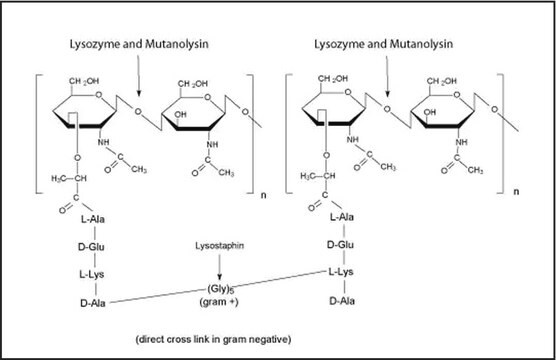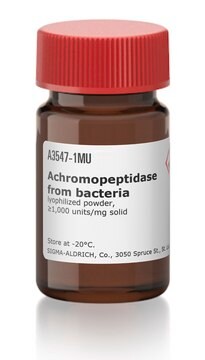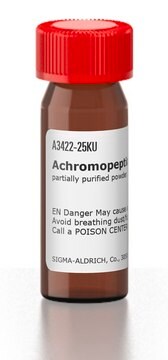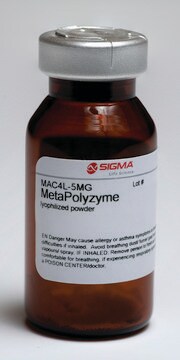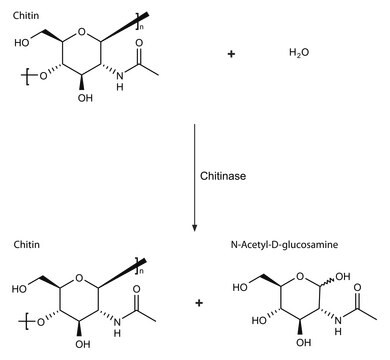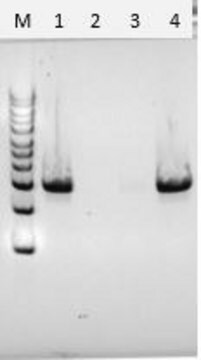SAE0196
Achromopeptidase from bacteria
free of DNA contaminants, suitable for Microbiome research
Sinónimos:
Bacterial Protease
Iniciar sesiónpara Ver la Fijación de precios por contrato y de la organización
About This Item
Código UNSPSC:
12352204
NACRES:
NA.54
Productos recomendados
origen biológico
bacterial
Nivel de calidad
formulario
lyophilized powder
actividad específica
≥1000 U/mg
Características
DNA free
técnicas
DNA extraction: suitable
idoneidad
suitable for cell lysis
aplicaciones
cell analysis
Condiciones de envío
ambient
temp. de almacenamiento
−20°C
Descripción general
Achromopeptidase is useful for lysis of Gram-positive bacteria that are resistant to lysozyme, as well as Gram-negative organisms. Achromopeptidase has been shown to contain two bacteriolytic proteases. This product is free of detectable microbial DNA and is suitable for microbiome research
Aplicación
Achromopeptidase is useful for lysis of Gram-positive bacteria that are resistant to lysozyme, as well as Gram-negative organisms. Achromopeptidase has been shown to contain two bacteriolytic proteases.
The study of microbial communities has been revolutionized in recent years by the widespread adoption of culture independent analytical techniques such as 16S rRNA gene sequencing and metagenomics. Since DNA contamination during sample preparation is a major problem of these sequence-based approaches, DNA extraction reagents free of DNA contaminants are essential. This product undergoes strict quality control testing to ensure the absence of detectable levels of contaminating microbial DNA using 35 cycles PCR amplification of 16S and 18S rDNA using universal primer sets.
The study of microbial communities has been revolutionized in recent years by the widespread adoption of culture independent analytical techniques such as 16S rRNA gene sequencing and metagenomics. Since DNA contamination during sample preparation is a major problem of these sequence-based approaches, DNA extraction reagents free of DNA contaminants are essential. This product undergoes strict quality control testing to ensure the absence of detectable levels of contaminating microbial DNA using 35 cycles PCR amplification of 16S and 18S rDNA using universal primer sets.
Acciones bioquímicas o fisiológicas
Achromopeptidase is a lysyl endopeptidase that has a molecular weight of approximately 27 kDa. Optimum pH is 8.5-9.
Características y beneficios
Contains two bacteriolytic proteases for efficient lysis of Gram-positive bacteria and Gram-negative organisms
Free of detectable microbial DNA, ensuring the accuracy of metagenomics and other culture-independent sequencing methods
Undergoes strict quality control testing to ensure the absence of detectable levels of contaminating microbial DNA
Optimum pH of 8.5-9 allows for use in a wide range of microbiome studies
Free of detectable microbial DNA, ensuring the accuracy of metagenomics and other culture-independent sequencing methods
Undergoes strict quality control testing to ensure the absence of detectable levels of contaminating microbial DNA
Optimum pH of 8.5-9 allows for use in a wide range of microbiome studies
Definición de unidad
One unit will lyse 0.4 μg of Micrococcus lysodeikticus per minute by turbidimetric detection at 600 nm when suspended in buffer at pH 8.0 at 37 °C.
Palabra de señalización
Danger
Frases de peligro
Consejos de prudencia
Clasificaciones de peligro
Resp. Sens. 1
Código de clase de almacenamiento
11 - Combustible Solids
Clase de riesgo para el agua (WGK)
WGK 3
Punto de inflamabilidad (°F)
Not applicable
Punto de inflamabilidad (°C)
Not applicable
Certificados de análisis (COA)
Busque Certificados de análisis (COA) introduciendo el número de lote del producto. Los números de lote se encuentran en la etiqueta del producto después de las palabras «Lot» o «Batch»
¿Ya tiene este producto?
Encuentre la documentación para los productos que ha comprado recientemente en la Biblioteca de documentos.
Nuestro equipo de científicos tiene experiencia en todas las áreas de investigación: Ciencias de la vida, Ciencia de los materiales, Síntesis química, Cromatografía, Analítica y muchas otras.
Póngase en contacto con el Servicio técnico